CdS-Based Hydrothermal Photocatalysts for Complete Reductive Dehalogenation of a Chlorinated Propionic Acid in Water by Visible Light
Abstract
1. Introduction
2. Materials and Methods
2.1. Materials
2.2. Preparation of Photocatalysts and Photoelectrodes
2.3. Morphology, Structure, and Composition of the Photocatalysts
2.4. Steady State Optical Absorption Measurements
2.5. Electro- and Photoelectrochemical Investigation
2.6. Photocatalytic Experiments
2.7. HPLC-MS Analysis
2.8. ESR Spin Trapping Experiments
2.9. ICP-MS Analysis
3. Results and Discussion
3.1. Structural and Optical Properties
3.2. Electro- and Photoelectrochemical Characterization
3.3. Photocatalytic Activity of CdS-HT and of CdS-HTa
3.4. Dependence of Photocatalytic Activity of CdS-HTa on Its Electronic Structure
4. Conclusions
Supplementary Materials
Author Contributions
Funding
Data Availability Statement
Conflicts of Interest
References
- Tsao, C.W.; Fang, M.J.; Hsu, Y.J. Modulation of interfacial charge dynamics of semiconductor heterostructures for advanced photocatalytic applications. Coord. Chem. Rev. 2021, 438, 213876. [Google Scholar] [CrossRef]
- Fang, M.J.; Tsao, C.W.; Hsu, Y.J. Semiconductor nanoheterostructures for photoconversion applications. J. Phys. D Appl. Phys. 2020, 53, 143001. [Google Scholar] [CrossRef]
- Ma, D.; Shi, J.W.; Zou, Y.; Fan, Z.; Ji, X.; Niu, C. Highly Efficient Photocatalyst Based on a CdS Quantum Dots/ZnO Nanosheets 0D/2D Heterojunction for Hydrogen Evolution from Water Splitting. ACS Appl. Mater. Interfaces 2017, 9, 25377–25386. [Google Scholar] [CrossRef] [PubMed]
- Bera, R.; Dutta, A.; Kundu, S.; Polshettiwar, V.; Patra, A. Design of a CdS/CdSe Heterostructure for Efficient H2 Generation and Photovoltaic Applications. J. Phys. Chem. C 2018, 122, 12158–12167. [Google Scholar] [CrossRef]
- Ma, D.; Shi, J.W.; Zou, Y.; Fan, Z.; Ji, X.; Niu, C.; Wang, L. Rational design of CdS@ZnO core-shell structure via atomic layer deposition for drastically enhanced photocatalytic H2 evolution with excellent photostability. Nano Energy 2017, 39, 183–191. [Google Scholar] [CrossRef]
- Gaya, U.I.; Abdullah, A.H. Heterogeneous photocatalytic degradation of organic contaminants over titanium dioxide: A review of fundamentals, progress and problems. J. Photochem. Photobiol. C Photochem. Rev. 2008, 9, 1–12. [Google Scholar] [CrossRef]
- Pichat, P. Photocatalysis and Water Purification: From Fundamentals to Recent Applications (Materials for Sustainable Energy and Development); Wiley: Hoboken, NJ, USA, 2013. [Google Scholar]
- Dong, F.; Zhu, J.; Li, J.; Fu, C.; He, G.; Lin, Q.; Li, C.; Song, S. The occurrence, formation and transformation of disinfection byproducts in the water distribution system: A review. Sci. Total Environ. 2023, 867, 161497. [Google Scholar] [CrossRef]
- Remucal, C.K.; Manley, D. Emerging investigators series: The efficacy of chlorine photolysis as an advanced oxidation process for drinking water treatment. Environ. Sci. Water Res. Technol. 2016, 2, 565–579. [Google Scholar] [CrossRef]
- Huang, W.C.; Liu, M.; Zhang, F.G.; Li, D.; Du, Y.; Chen, Y.; Wu, Q.Y. Removal of disinfection byproducts and toxicity of chlorinated water by post-treatments of ultraviolet/hydrogen peroxide and ultraviolet/peroxymonosulfate. J. Clean. Prod. 2022, 352, 131563. [Google Scholar] [CrossRef]
- Gallidabino, M.D.; Hamdan, L.; Murphy, B.; Barron, L.P. Suspect screening of halogenated carboxylic acids in drinking water using ion exchange chromatography–high resolution (Orbitrap) mass spectrometry (IC-HRMS). Talanta 2018, 178, 57–68. [Google Scholar] [CrossRef]
- Hawker, D.W.; Cumming, J.L.; Watkinson, A.; Bartkow, M.E. The occurrence of the herbicide dalapon (2,2-dichloropropionate) in potable water as a disinfection by-product. J. Environ. Monit. 2011, 13, 252–256. [Google Scholar] [CrossRef] [PubMed][Green Version]
- Calza, P.; Minero, C.; Pelizzetti, E. Photocatalytically assisted hydrolysis of chlorinated methanes under anaerobic conditions. Environ. Sci. Technol. 1997, 31, 2198–2203. [Google Scholar] [CrossRef]
- El-Morsi, T.M.; Budakowski, W.R.; Abd-El-Aziz, A.S.; Friesen, K.J. Photocatalytic Degradation of 1,10-Dichlorodecane in Aqueous Suspensions of TiO2: A Reaction of Adsorbed Chlorinated Alkane with Surface Hydroxyl Radicals. Environ. Sci. Technol. 2000, 34, 1018–1022. [Google Scholar] [CrossRef]
- Hara, T.; Kaneta, T.; Mori, K.; Mitsudome, T.; Mizugaki, T.; Ebitani, K.; Kaneda, K. Magnetically recoverable heterogeneous catalyst: Palladium nanocluster supported on hydroxyapatite-encapsulated γ-Fe2O3 nanocrystallites for highly efficient dehalogenation with molecular hydrogen. Green Chem. 2007, 9, 1246–1251. [Google Scholar] [CrossRef]
- Wang, Y.; Zhu, Q.; Wei, Y.; Gong, Y.; Chen, C.; Song, W.; Zhao, J. Catalytic hydrodehalogenation over supported gold: Electron transfer versus hydride transfer. Appl. Catal. B 2018, 231, 262–268. [Google Scholar] [CrossRef]
- Isse, A.A.; Gottardello, S.; Durante, C.; Gennaro, A. Dissociative electron transfer to organic chlorides: Electrocatalysis at metal cathodes. Phys. Chem. Chem. Phys. 2008, 10, 2409–2416. [Google Scholar] [CrossRef]
- Zhuang, Y.; Ahn, S.; Seyfferth, A.L.; Masue-Slowey, Y.; Fendorf, S.; Luthy, R.G. Dehalogenation of Polybrominated Diphenyl Ethers and Polychlorinated Biphenyl by Bimetallic, Impregnated, and Nanoscale Zerovalent Iron. Environ. Sci. Technol. 2011, 45, 4896–4903. [Google Scholar] [CrossRef]
- Wang, Y.; Wei, Y.; Song, W.; Chen, C.; Zhao, J. Photocatalytic Hydrodehalogenation for the Removal of Halogenated Aromatic Contaminants. ChemCatChem 2019, 11, 258–268. [Google Scholar] [CrossRef]
- Li, L.; Chang, W.; Wang, Y.; Ji, H.; Chen, C.; Ma, W.; Zhao, J. Rapid, Photocatalytic, and Deep Debromination of Polybrominated Diphenyl Ethers on Pd–TiO2: Intermediates and Pathways. Chem. Eur. J. 2014, 20, 11163–11170. [Google Scholar] [CrossRef]
- Lei, M.; Wang, N.; Zhu, L.; Zhou, Q.; Nie, G.; Tang, H. Photocatalytic reductive degradation of polybrominated diphenyl ethers on CuO/TiO2 nanocomposites: A mechanism based on the switching of photocatalytic reduction potential being controlled by the valence state of copper. Appl. Catal. B 2016, 182, 414–423. [Google Scholar] [CrossRef]
- Fuku, K.; Hashimoto, K.; Kominami, H. Photocatalyic reductive dechlorination of chlorobenzene to benzene in 2-propanol suspension of metal-loaded titanium (IV) oxide nanocrystals in the presence of dissolved sodium hydroxide. Chem. Comm. 2010, 46, 5118–5120. [Google Scholar] [CrossRef] [PubMed]
- Yin, H.; Wada, Y.; Kitamura, T.; Yanagida, S. Photoreductive Dehalogenation of Halogenated Benzene Derivatives Using ZnS or CdS Nanocrystallites as Photocatalysts. Environ. Sci. Technol. 2001, 35, 227–231. [Google Scholar] [CrossRef]
- Schultz, D.M.; Yoon, T.P. Solar synthesis: Prospects in visible light photocatlysis. Science 2014, 343, 1239176. [Google Scholar] [CrossRef]
- Chen, C.; Ma, W.; Zhao, J. Semiconductor-mediated photodegradation of pollutants under visible-light irradiation. Chem. Soc. Rev. 2010, 39, 4206–4219. [Google Scholar] [CrossRef]
- Yin, H.; Wada, Y.; Kitamura, T.; Sakata, T.; Mori, H.; Yanagida, S. Enhanced Photocatalytic Dechlorination of 1,2,3,4-Tetrachlorobenzene Using Nanosized CdS/TiO2 Hybrid Photocatalyst under Visible Light Irradiation. Chem. Lett. 2001, 30, 334–335. [Google Scholar] [CrossRef]
- Milani, M.; Mazzanti, M.; Caramori, S.; Di Carmine, G.; Magnacca, G.; Molinari, A. Composite CdS/TiO2 Powders in the Se-lective Reduction of 4-Nitrobenzaldehyde by Visible Light: Relation between Preparation, Morphology and Photocatalytic Activity. Catalysts 2022, 13, 74. [Google Scholar] [CrossRef]
- Mazzanti, M.; Milani, M.; Cristino, V.; Boaretto, R.; Molinari, A.; Carmori, S. Visible Light Reductive Photocatalysis of Azo-Dyes with n–n Junctions Based on Chemically Deposited CdS. Molecules 2022, 27, 2924. [Google Scholar] [CrossRef] [PubMed]
- Qi, M.Y.; Lin, Q.; Tang, Z.R.; Xu, Y.J. Photoredox coupling of benzyl alcohol oxidation with CO2 reduction over CdS/TiO2 heterostructure under visible light irradiation. Appl. Catal. B 2022, 307, 121158. [Google Scholar] [CrossRef]
- Pal, A.; Ghosh, I.; Sapra, S.; König, B. Quantum Dots in Visible-Light Photoredox Catalysis: Reductive Dehalogenations and C–H Arylation Reactions Using Aryl Bromides. Chem. Mater. 2017, 29, 5225–5231. [Google Scholar] [CrossRef]
- Bahnemann, D.W.; Monig, J.; Chapman, R. Efficient Photocatalysis of the Irreversible One-Electron and Two-Electron Reduction of Halothane on Platinized Colloidal Titanium Dioxide in Aqueous Suspension. J. Phys. Chem. 1987, 91, 3782–3788. [Google Scholar] [CrossRef]
- Milani, M.; Mazzanti, M.; Magnacca, G.; Caramori, S.; Molinari, A. A Novel Hydrothermal CdS with Enhanced Photocatalytic Activity and Photostability for Visible Light Hydrogenation of Azo Bond: Synthesis and Characterization. Nanomaterials 2023, 13, 413. [Google Scholar] [CrossRef] [PubMed]
- Kaczyński, P.; Łozowicka, B.; Jankowska, M.; Hrynko, I. Rapid determination of acid herbicides in soil by liquid chromatography with tandem mass spectrometric detection based on dispersive solid phase extraction. Talanta 2016, 152, 127–136. [Google Scholar] [CrossRef]
- Rao, B.S.; Rajesh Kumar, B.; Reddy, V.R.; Rao, T.S. Preparation and characterization of CdS nanoparticles by chemical co-precipitation technique. Chalcogenide Lett. 2011, 8, 177–185. [Google Scholar]
- Haghshenas, N.; Falletta, E.; Cerrato, G.; Giordana, A.; Bianchi, C.L. Tuning the visible-light-driven photocatalytic properties of multi-decorated TiO2 by noble metals towards both propionic acid and NOx degradation. Catal. Commun. 2023, 181, 106728. [Google Scholar] [CrossRef]
- Betts, L.M.; Dappozze, F.; Guillard, C. Understanding the photocatalytic degradation by P25 TiO2 of acetic acid and propionic acid in the pursuit of alkane production. Appl. Catal. A Gen. 2018, 554, 35–43. [Google Scholar] [CrossRef]
- Molinari, A.; Maldotti, A.; Amadelli, R. A photo-(electro)-catalytic system illustrating the effect of lithium ions on titania surface energetics and charge transfer. J. Electroanal. Chem. 2015, 755, 143–150. [Google Scholar] [CrossRef]
- Molinari, A.; Maldotti, A.; Amadelli, R. Heterogeneous photocatalytic systems for partial and selective oxidation of alcohols and polyols. Curr. Org. Chem. 2013, 17, 2382–2405. [Google Scholar] [CrossRef]
- Molinari, A.; Maldotti, A.; Amadelli, R. Effect of the electrolyte cations on photoinduced charge transfer at TiO2. Catal. Today 2017, 281, 71–77. [Google Scholar] [CrossRef]
- Buetter, G.R. Spin Trapping: ESR parameters of spin adducts 1474 1528V. Free Radic. Biol. Med. 1987, 3, 259–303. [Google Scholar] [CrossRef]
- Yin, H.; Cao, X.; Lei, C.; Chen, W.; Huan, B. Insights into electroreductive dehalogenation mechanisms of chlorinated environmental pollutants. ChemElectroChem 2020, 7, 1825–1837. [Google Scholar] [CrossRef]
- Scialdone, O.; Guarisco, C.; Galia, A.; Herbois, R. Electroreduction of aliphatic chlorides at silver cathodes in water. J. Electroanal. Chem. 2010, 641, 14–22. [Google Scholar] [CrossRef]
- Randazzo, S.; Scialdone, O.; Brillas, E.; Sires, I. Comparative electrochemical treatments of two chlorinated aliphatic hydrocarbons. Time course of the main reaction by-products. J. Hazard. Mater. 2011, 192, 1555–1564. [Google Scholar] [CrossRef] [PubMed]
- Cheng, L.; Xiang, Q.; Liao, Y.; Zhang, H. CdS-based photocatalysts. Energy Environ. Sci. 2018, 11, 1362–1391. [Google Scholar] [CrossRef]
- Xiong, P.; Zhu, J.; Wang, X. Cadmium sulfide-ferrite nanocomposite as a magnetically recyclable photocatalyst with enhanced visible-light-driven photocatalytic activity and photostability. Ind. Eng. Chem. Res. 2013, 52, 17126–17133. [Google Scholar] [CrossRef]
- Senasu, T.; Hemavibool, K.; Nanan, S. Application of Nanoparticles in Environmental Cleanup: Production, Potential Risks and Solutions. RSC Adv. 2018, 8, 22592–22605. [Google Scholar] [CrossRef]
- Yan, Y.; Zhou, Z.; Li, W.; Zhu, Y.; Cheng, Y.; Zhao, F.; Zhou, J. Facile ion-exchange synthesis of urchin-shaped CdS/Bi2S3 heterostructures with enhanced photostability and visible light photocatalytic activity. RSC Adv. 2014, 4, 38558–38567. [Google Scholar] [CrossRef]
- Available online: https://www.epa.gov/ground-water-and-drinking-water/national-primary-drinking-water-regulations#Inorganic (accessed on 7 February 2024).

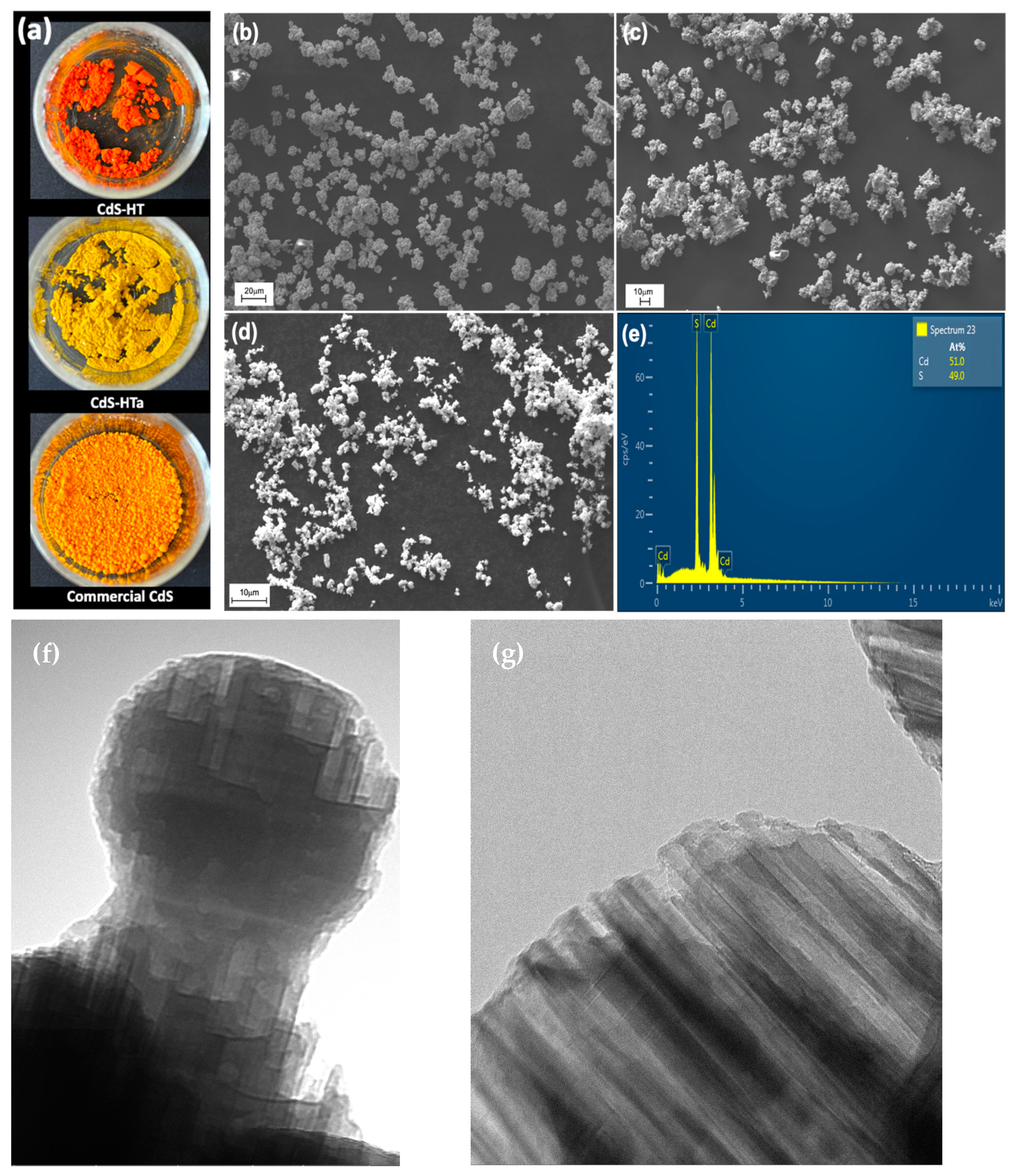
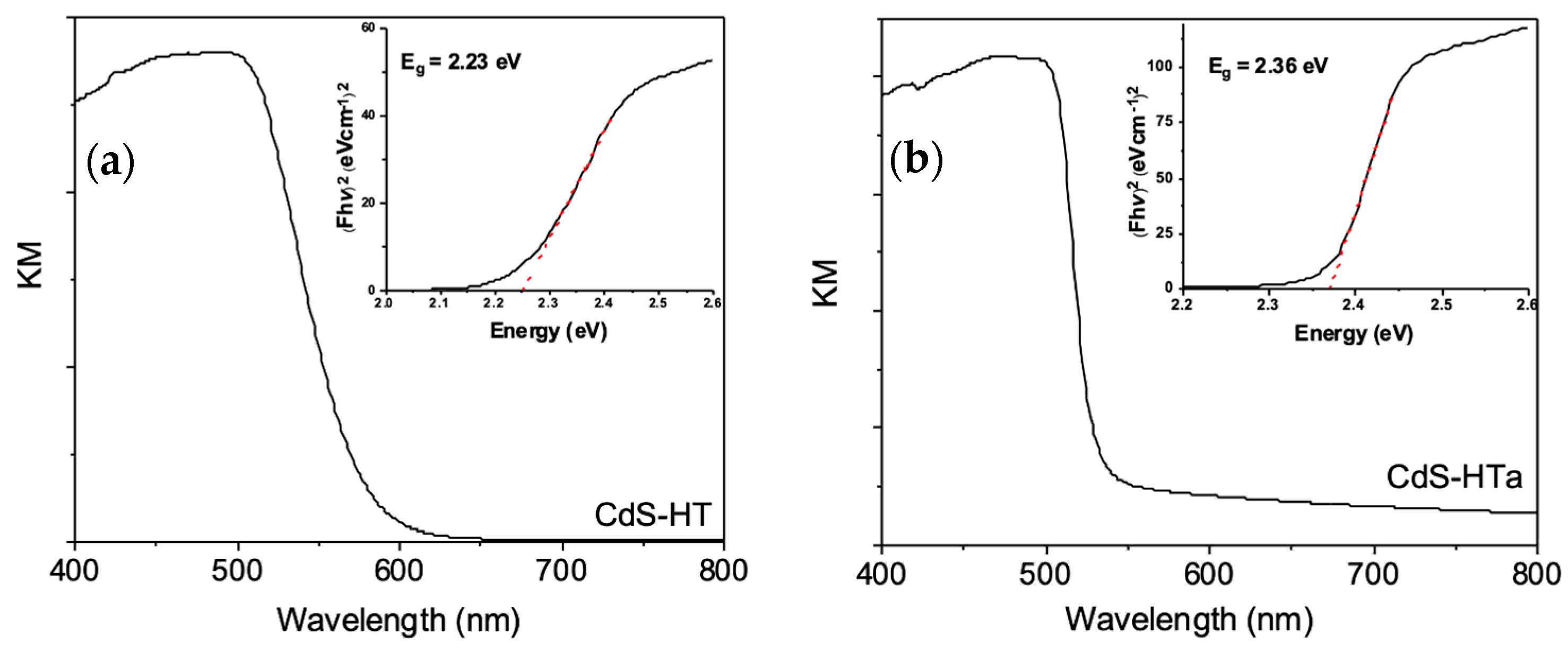
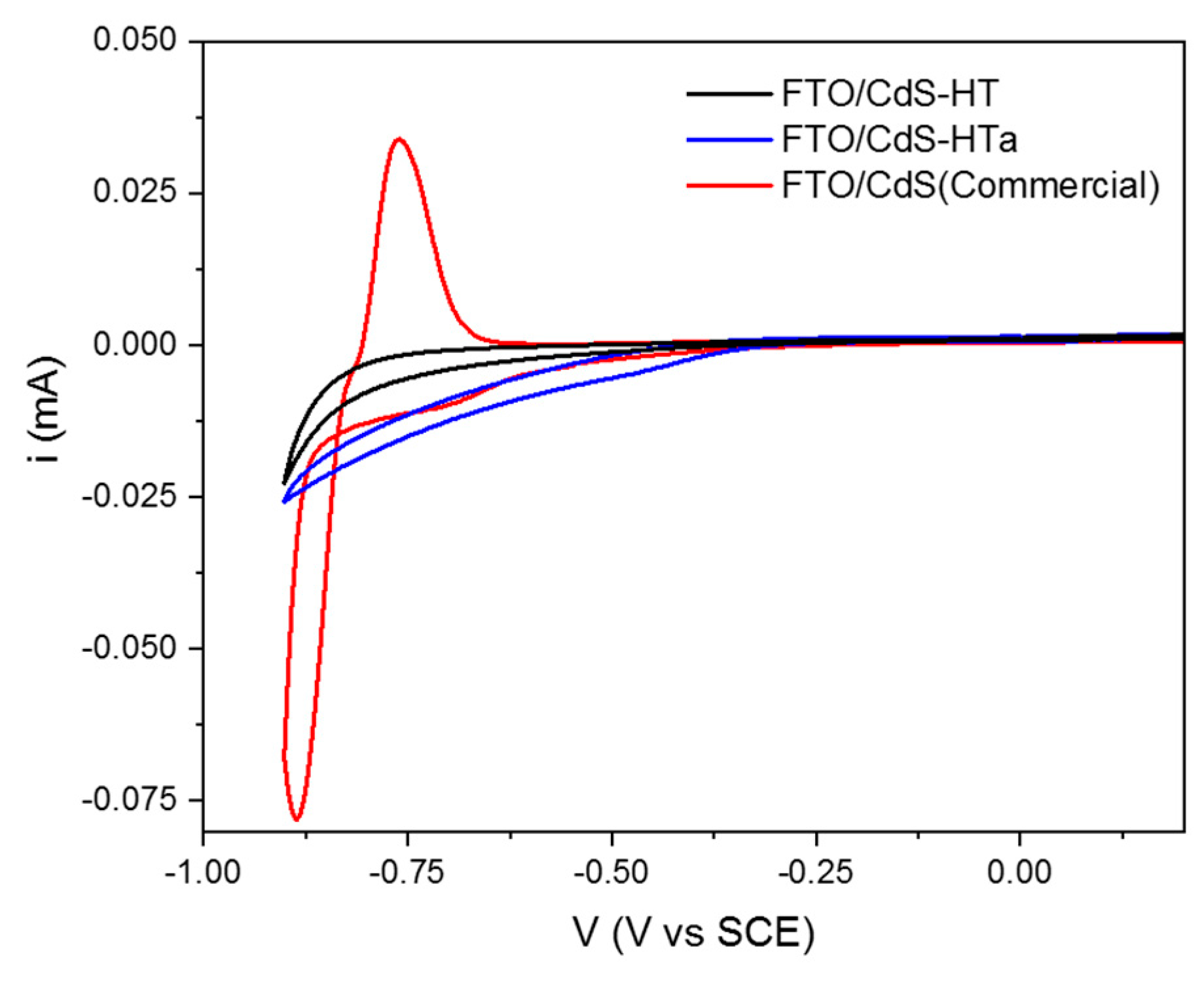
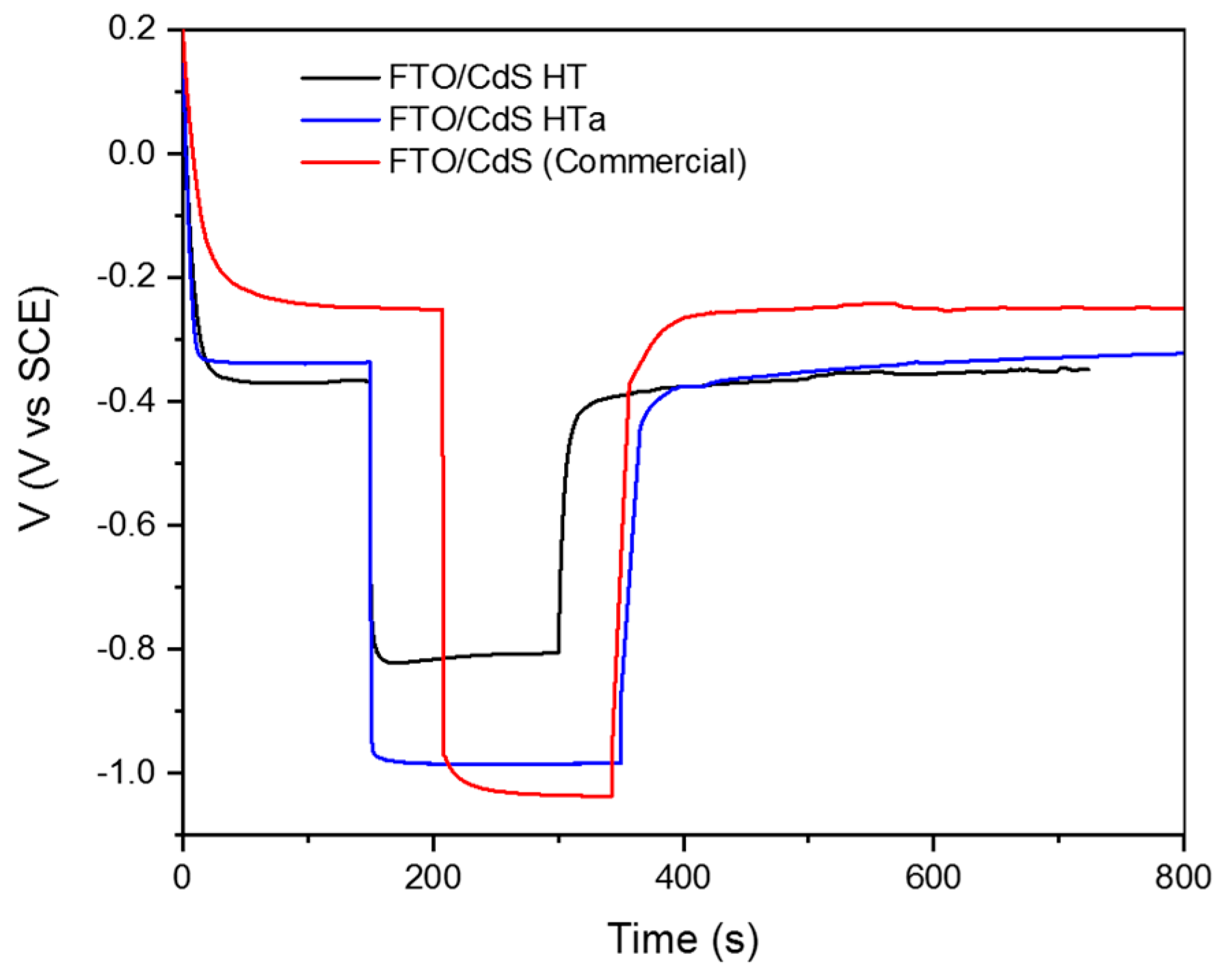
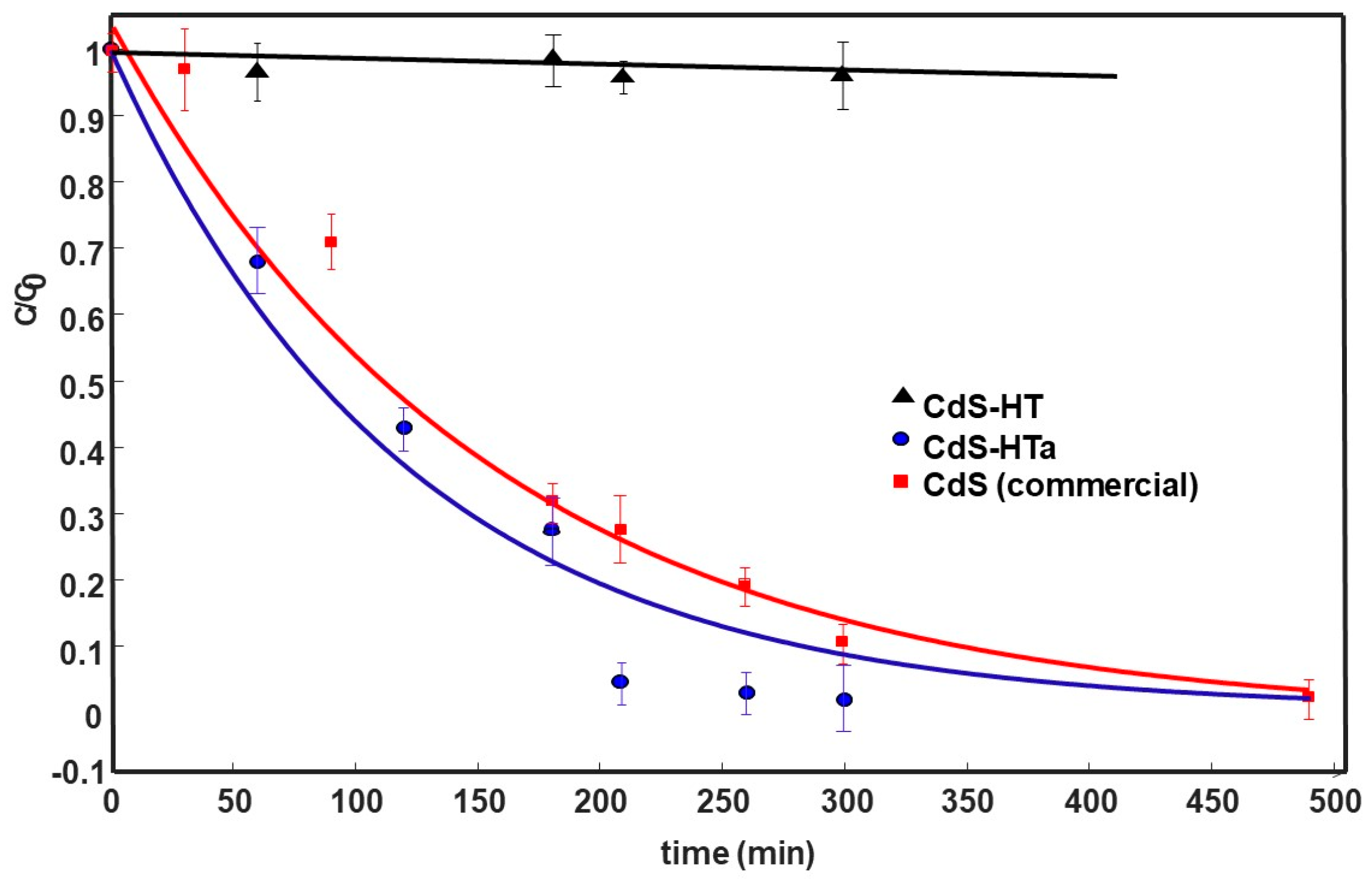
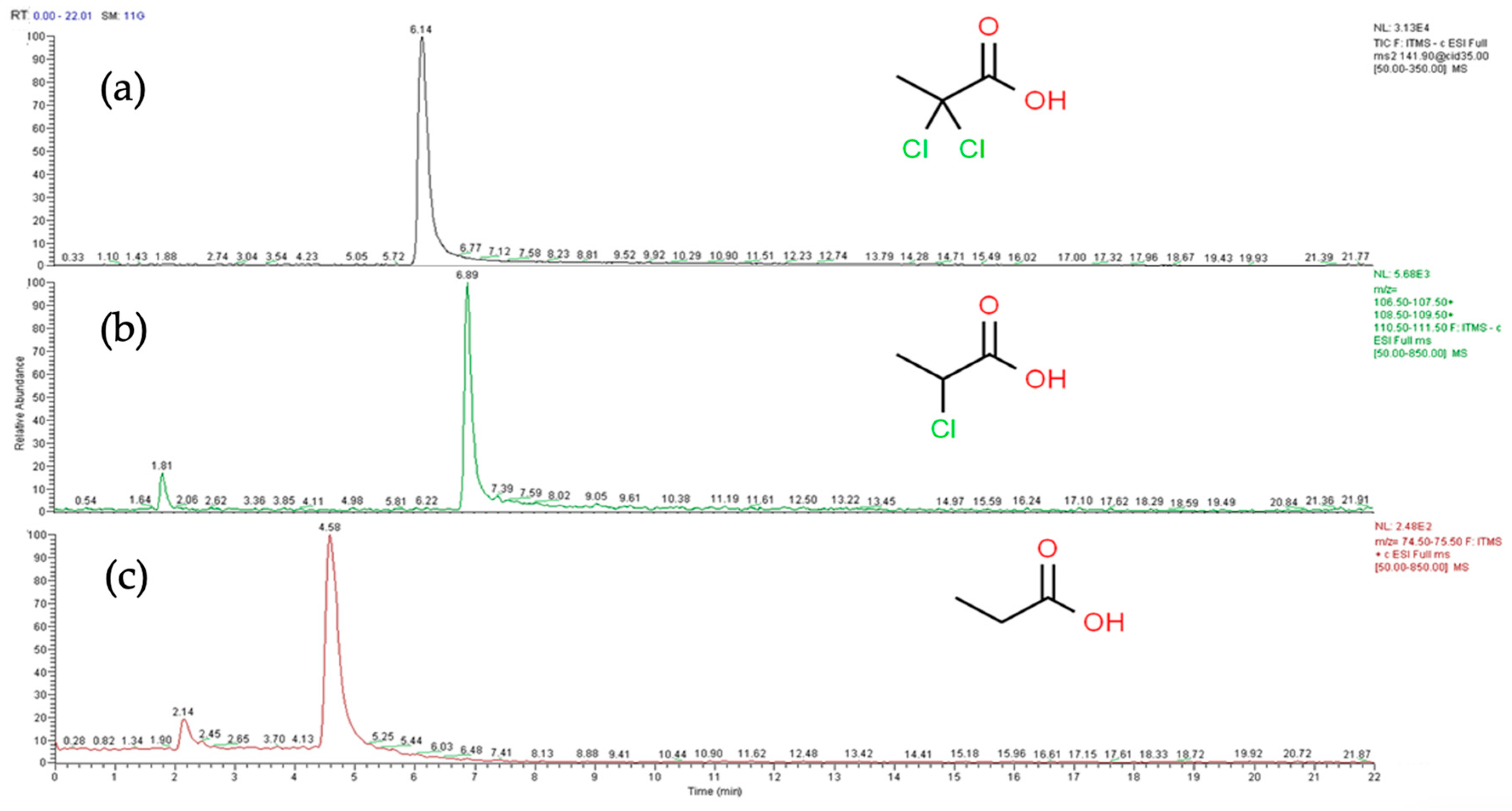
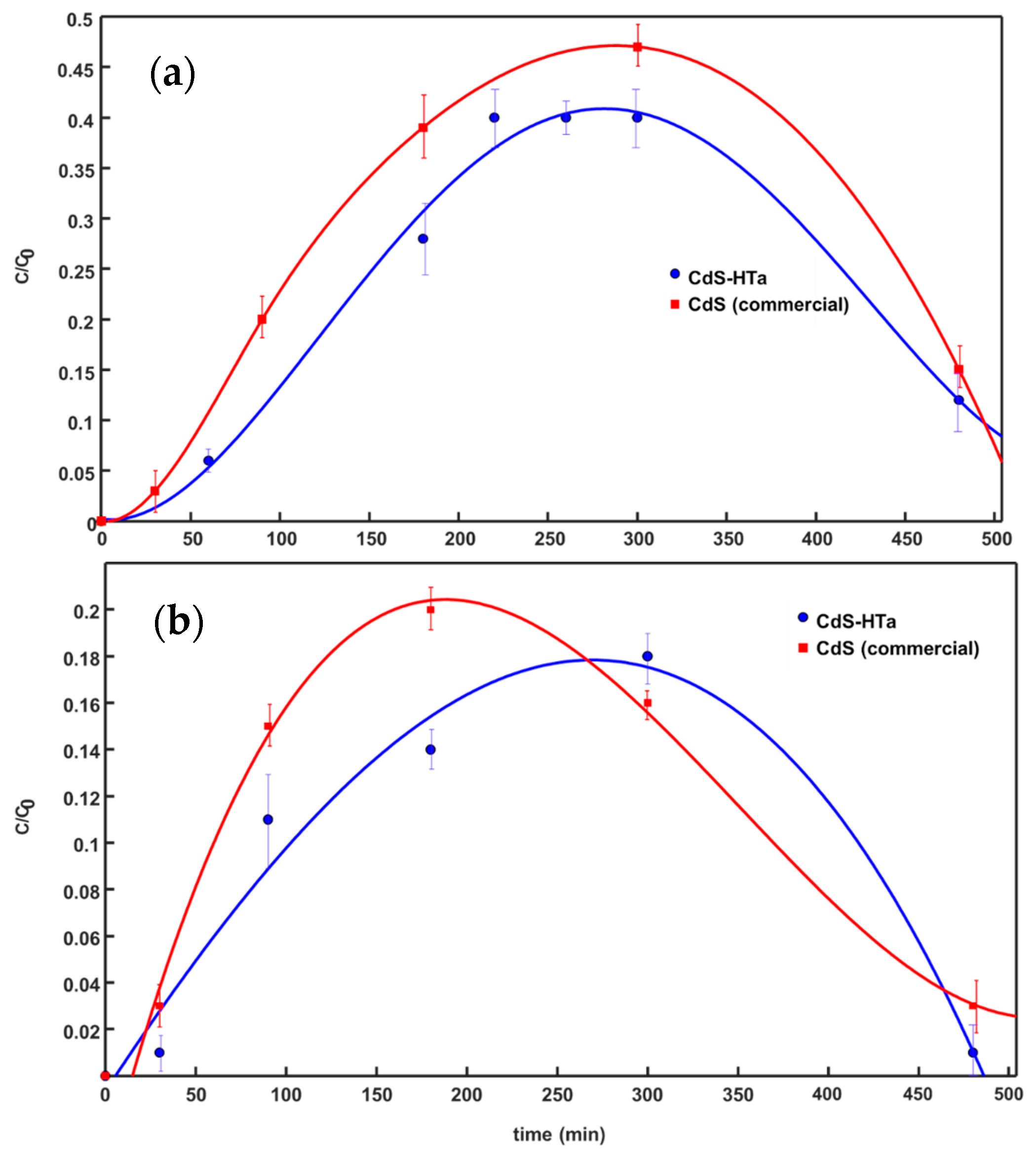
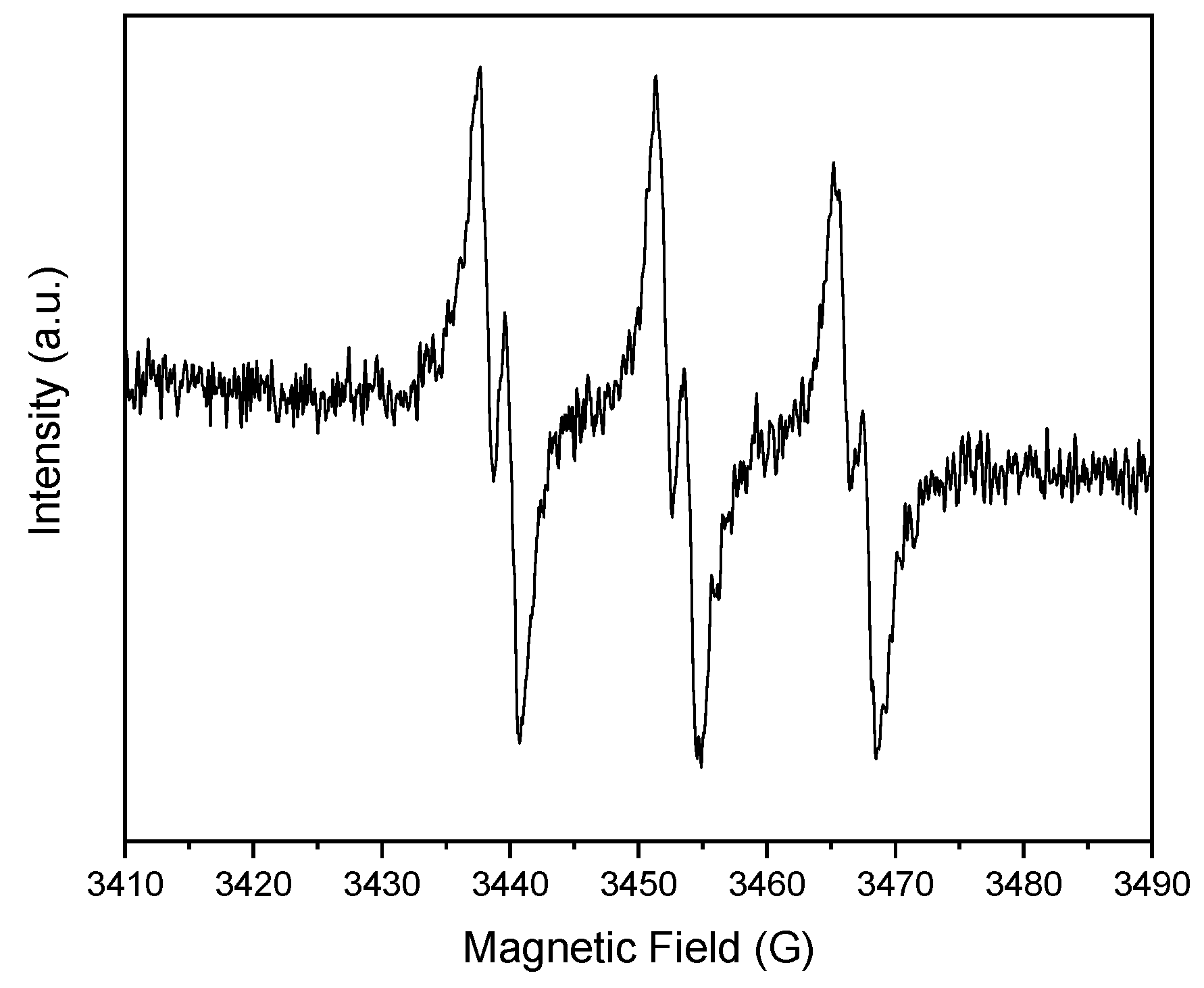

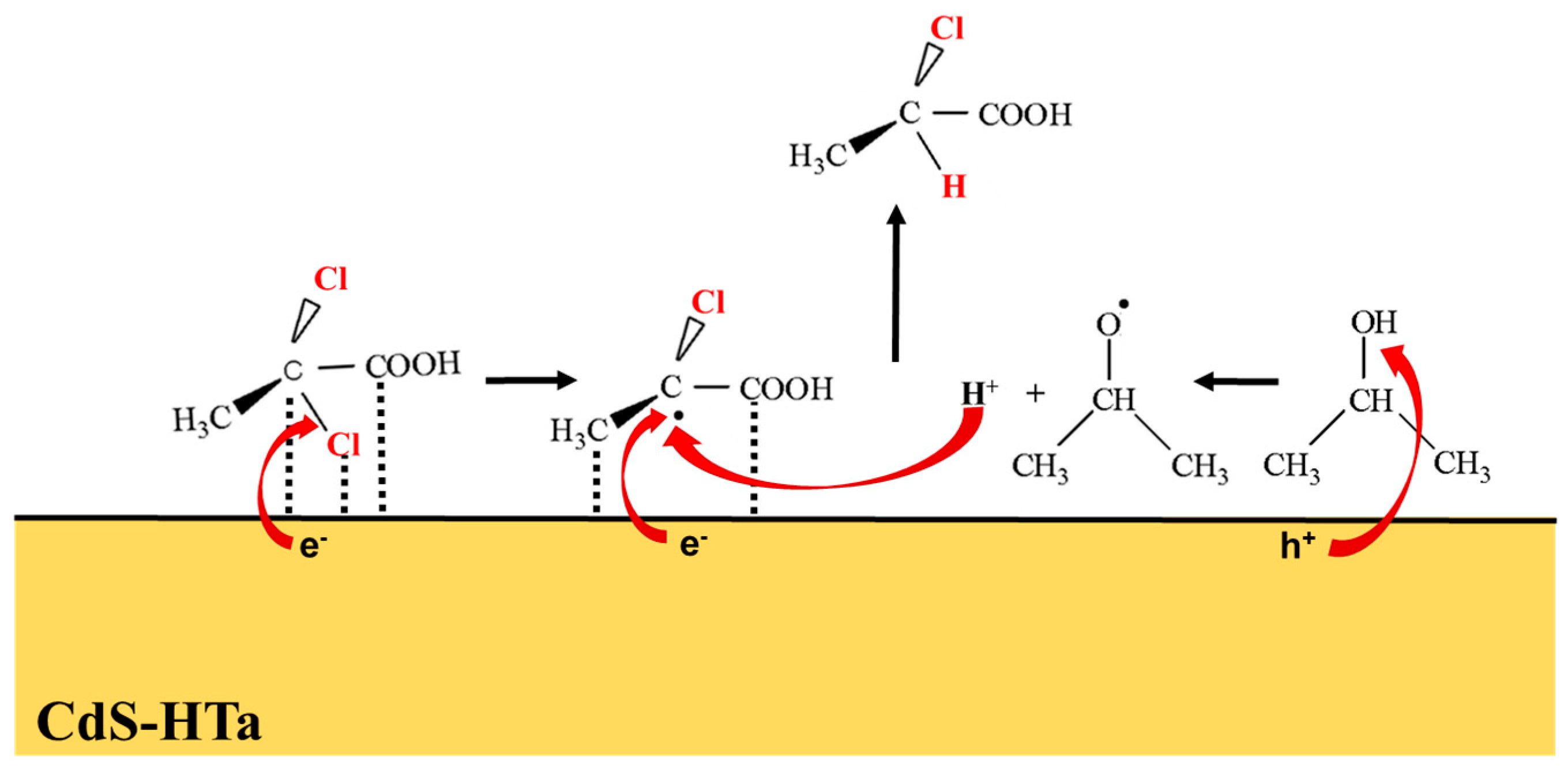
Disclaimer/Publisher’s Note: The statements, opinions and data contained in all publications are solely those of the individual author(s) and contributor(s) and not of MDPI and/or the editor(s). MDPI and/or the editor(s) disclaim responsibility for any injury to people or property resulting from any ideas, methods, instructions or products referred to in the content. |
© 2024 by the authors. Licensee MDPI, Basel, Switzerland. This article is an open access article distributed under the terms and conditions of the Creative Commons Attribution (CC BY) license (https://creativecommons.org/licenses/by/4.0/).
Share and Cite
Milani, M.; Mazzanti, M.; Stevanin, C.; Chenet, T.; Magnacca, G.; Pasti, L.; Molinari, A. CdS-Based Hydrothermal Photocatalysts for Complete Reductive Dehalogenation of a Chlorinated Propionic Acid in Water by Visible Light. Nanomaterials 2024, 14, 579. https://doi.org/10.3390/nano14070579
Milani M, Mazzanti M, Stevanin C, Chenet T, Magnacca G, Pasti L, Molinari A. CdS-Based Hydrothermal Photocatalysts for Complete Reductive Dehalogenation of a Chlorinated Propionic Acid in Water by Visible Light. Nanomaterials. 2024; 14(7):579. https://doi.org/10.3390/nano14070579
Chicago/Turabian StyleMilani, Martina, Michele Mazzanti, Claudia Stevanin, Tatiana Chenet, Giuliana Magnacca, Luisa Pasti, and Alessandra Molinari. 2024. "CdS-Based Hydrothermal Photocatalysts for Complete Reductive Dehalogenation of a Chlorinated Propionic Acid in Water by Visible Light" Nanomaterials 14, no. 7: 579. https://doi.org/10.3390/nano14070579
APA StyleMilani, M., Mazzanti, M., Stevanin, C., Chenet, T., Magnacca, G., Pasti, L., & Molinari, A. (2024). CdS-Based Hydrothermal Photocatalysts for Complete Reductive Dehalogenation of a Chlorinated Propionic Acid in Water by Visible Light. Nanomaterials, 14(7), 579. https://doi.org/10.3390/nano14070579






